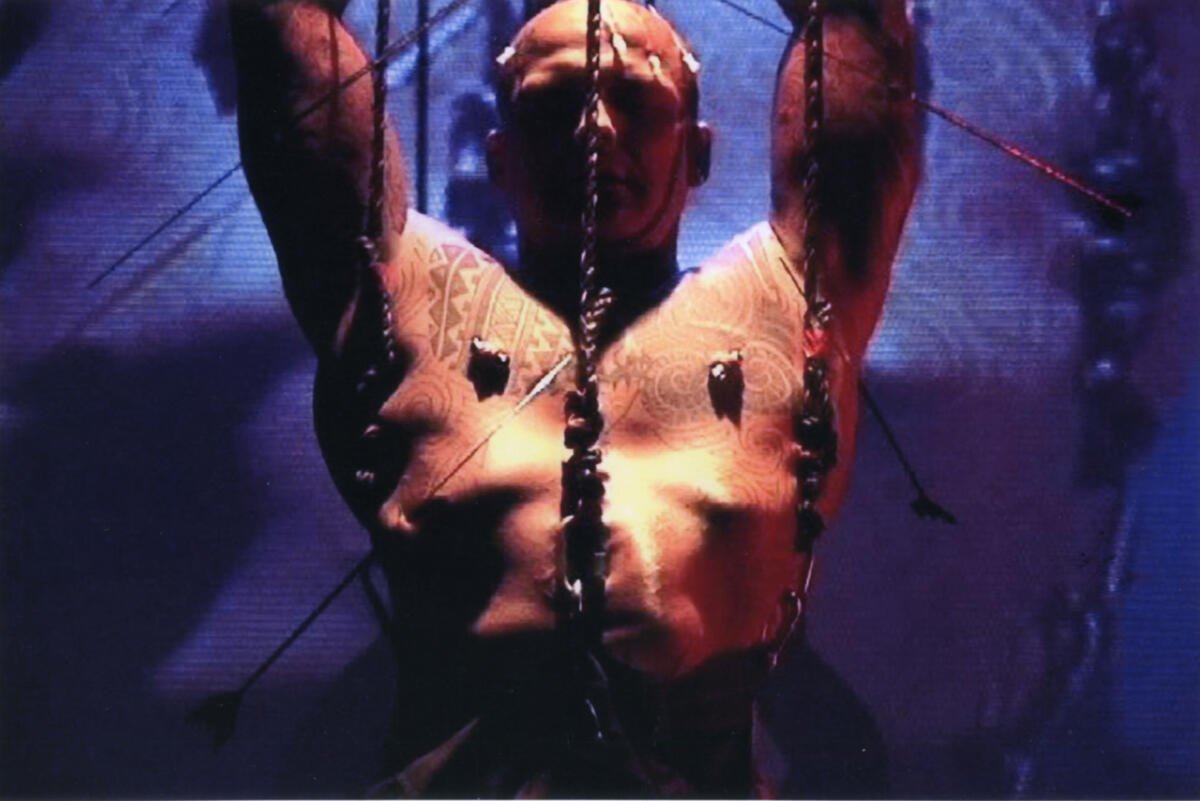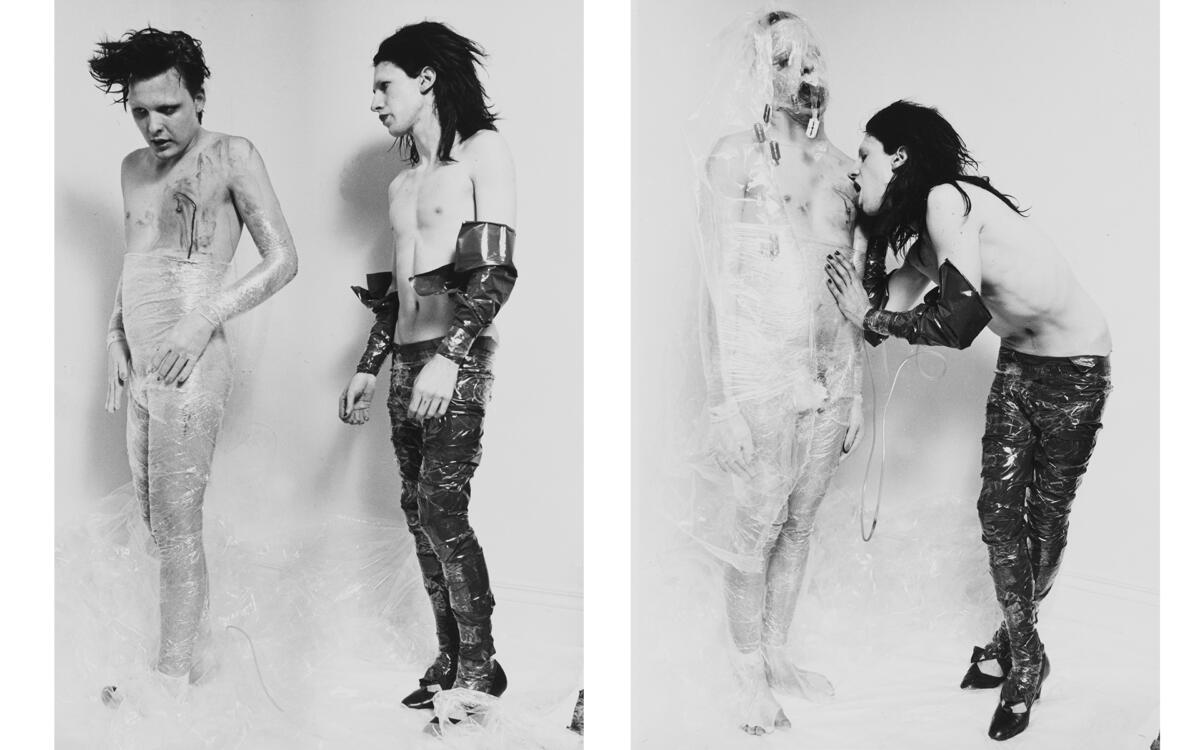“You have to make your legacy now,” says extreme body artist Ron Athey
Ron Athey, the North American performance art legend known for his works involving body manipulation, will be visiting Helsinki for the first time in November. He will be speaking at the invitation of the University of the Arts and Kiasma. The visit is a major event, as Athey is one of the most respected names in performance art. The event at Kiasma Theatre on 20.11. is open to the public.

Ron Athey (b. 1961) grew up in the realm of North American Pentecostal religion. An intense background in a charismatic religious movement, within which his grandmother brought him up to be a minister. By the age of ten, Athey was speaking in tongues, thinking his aunt was a prophet.
“Around this time, I was seen as the nine year old saint. That makes me an oddball.”
When the artist entered the punk scene of the early 80s, a body of work began to form.
“I was always being calmed down, but I knew magic would happen in these spaces.”
The work begins with 1981 Premature Ejaculation, a performance piece made in collaboration with Rozz Williams, Athey’s then partner and singer of Christian Death. The piece was informed by the formation of industrial culture and the idea of neuro acoustics in sound performance but also featured material of Athey eating crucified road-kill. Something which led to clubs refusing to book the act.
In the early 90s, Athey continued by staging his first major ensemble performances: Martyrs & Saints, Four Scenes in a Harsh Life, and Deliverance, a collection known as the The Torture Trilogy.
“The work that I did in the 90s was during the worst part of the AIDS epidemic. During The Torture Trilogy, I was visiting people dying all the time, since medication only arrived around 1996-1997. The work, fueled by sadness, was boasting with an effortless, screaming energy.”
An energy which came to a halt during the 1994 culture wars, even though Athey, at that time, “didn’t even know how to write an art grant.”
The movement that struggled to define America, was a war of conservative politicians fighting to bar artwork by anyone exhibiting gay or feminist content from receiving public funding.
“I was manipulated into it as I had performed at the Walker Art Center. Within two weeks I was getting exploited–having to explain the content of my work–and ultimately, that I was no monster.”
When in fact, excerpts from The Torture Trilogy had been staged with support from the center and the sold-out performance was well received by the audience. It did, however, feature Athey performing light cuts on a co-performer, something which, in the hands of the press and the concurring widespread AIDS anxiety, transformed into a shocked reaction from the wider public. It went as far as some critics and politicians claiming the artist was exposing audience members to infections through blood contamination.
“This fight then became my full time job, unfortunately.”
“But things break down and they do build up. I am always against nihilism, without going full Pollyanna. If everything shits around you, you can repiece something different from it.”

Athey began performing at the Institute of Contemporary Arts in London and went from “the stress of everyone dying and the intensity of fighting a culture war on not only the government but also the spaces”.
This, according to Athey, is a vital part of his artistic process. “Coming from the punk and death generation of AIDS, I do not wait. I make the work,” the artist states. “I have worked in newspapers for 19 years, I understand PR. I have the skills and the responsibility to carve out my context, making sure I am not only seen as a queer artist, or an AIDS artist.”
And then suddenly, “you wake up one day and you are an elder.”
How does an artist keep their work ongoing and fresh, while making sure that a legacy is left behind?
“I would not say that I keep my work fresh, but rather that I keep work possible.”
From the earliest pieces and productions, Athey has gravitated towards overwrought theatre: “I want scenes, a full format design, I want a chorus, I want to work with 25 people–and I want backup singers. I always make work that is too expensive for the context that I am given.”
“Yet I still think Solar Anus is some of my best work.”
The piece, performed between 1998-2006 was Athey’s first solo performance. It featured self-harm, the use of blood as material and the ass-hole that honours the anus as a weapon of power. According to Vice Magazine, “It’s not easy to comprehend why someone would want to penetrate his scalp with a metal hook, infuse his scrotum with saline solution, and invite a live audience to watch.”
“I am a more is more person,” Athey laughs.
“I am not interested in making six hour performances. I tried it once but am certainly not a durational artist. I don’t care if the trend is to do one-on-one performances that last a long time, it just does not turn me on. And I do think a lot of performance art is boring.”
What instead gets the artist going is playing with a variety of things. The manipulated body is his biggest passion. To place proportions to the exposed body, making an imprint of a womb, placing condom-clad contact mics inside the body–exploring what the body can give. The artist gravitates towards painful performance, “When you accept the pain, you just get into it deep and that sort of ecstatic state allows me to explore and see where the performance goes.”
“And I always work with a hypnotist.”
But why?
“In my work, I am not trying to be a natural person. If I am developing a concept and hit a slowdown, hypnosis and the method of automatic writing will help me understand which way to go. It gives me a channel to work in.”
In this work, Athey is always exploring philosophical and psychic aspects. Yet while he often works with the extreme body, he also identifies as an illusionist, sometimes using fake blood or fake organs in his performances. Magic, according to the artist, has the ability to stir something in us, and in that space, something healing can happen.
There will also eventually be a legacy, when one makes art for 45 years. The Getty has his paper archives and there is a published catalogue from the retrospective 2021 show, the Queer Communion: Ron Athey. A show which made Athey live every single timeline from the 80s to 2021, making him eventually feel fractured. After that, he felt he had enough of the retrospective world.
“As I said before, I do not wait around. I believe you have to make your legacy now.”
Text: Elena Sulin
Copyright of all images by Ron Athey
Artist talk at Kiasma Theatre
Ron Athey talks about his art on Wednesday 20.11. at 6 pm at Kiasma Theatre, interviewed by PhD researcher, performance artist Jamie MacDonald. The audience will have the opportunity to ask questions. Read more in the Uniarts Helsinki’s event calendar.